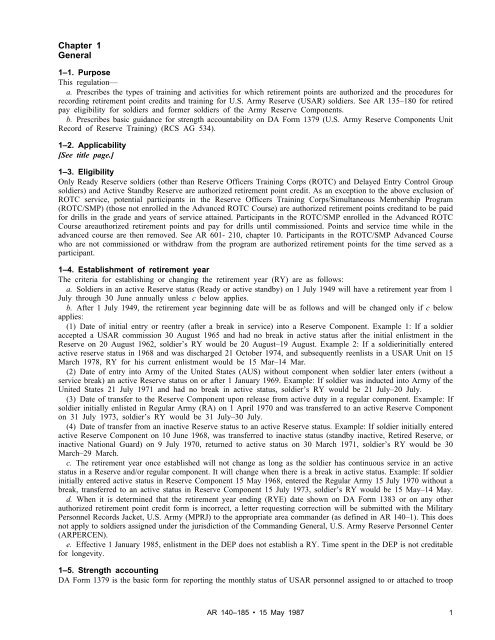Training and Retirement Point Credits and Unit Level ... - AskTOP
Training and Retirement Point Credits and Unit Level ... - AskTOP
Training and Retirement Point Credits and Unit Level ... - AskTOP
- No tags were found...
You also want an ePaper? Increase the reach of your titles
YUMPU automatically turns print PDFs into web optimized ePapers that Google loves.
Chapter 1General1–1. PurposeThis regulation—a. Prescribes the types of training <strong>and</strong> activities for which retirement points are authorized <strong>and</strong> the procedures forrecording retirement point credits <strong>and</strong> training for U.S. Army Reserve (USAR) soldiers. See AR 135–180 for retiredpay eligibility for soldiers <strong>and</strong> former soldiers of the Army Reserve Components.b. Prescribes basic guidance for strength accountability on DA Form 1379 (U.S. Army Reserve Components <strong>Unit</strong>Record of Reserve <strong>Training</strong>) (RCS AG 534).1–2. Applicability[See title page.]1–3. EligibilityOnly Ready Reserve soldiers (other than Reserve Officers <strong>Training</strong> Corps (ROTC) <strong>and</strong> Delayed Entry Control Groupsoldiers) <strong>and</strong> Active St<strong>and</strong>by Reserve are authorized retirement point credit. As an exception to the above exclusion ofROTC service, potential participants in the Reserve Officers <strong>Training</strong> Corps/Simultaneous Membership Program(ROTC/SMP) (those not enrolled in the Advanced ROTC Course) are authorized retirement points credit<strong>and</strong> to be paidfor drills in the grade <strong>and</strong> years of service attained. Participants in the ROTC/SMP enrolled in the Advanced ROTCCourse areauthorized retirement points <strong>and</strong> pay for drills until commissioned. <strong>Point</strong>s <strong>and</strong> service time while in theadvanced course are then removed. See AR 601- 210, chapter 10. Participants in the ROTC/SMP Advanced Coursewho are not commissioned or withdraw from the program are authorized retirement points for the time served as aparticipant.1–4. Establishment of retirement yearThe criteria for establishing or changing the retirement year (RY) are as follows:a. Soldiers in an active Reserve status (Ready or active st<strong>and</strong>by) on 1 July 1949 will have a retirement year from 1July through 30 June annually unless c below applies.b. After 1 July 1949, the retirement year beginning date will be as follows <strong>and</strong> will be changed only if c belowapplies:(1) Date of initial entry or reentry (after a break in service) into a Reserve Component. Example 1: If a soldieraccepted a USAR commission 30 August 1965 <strong>and</strong> had no break in active status after the initial enlistment in theReserve on 20 August 1962, soldier’s RY would be 20 August–19 August. Example 2: If a soldierinitially enteredactive reserve status in 1968 <strong>and</strong> was discharged 21 October 1974, <strong>and</strong> subsequently reenlists in a USAR <strong>Unit</strong> on 15March 1978, RY for his current enlistment would be 15 Mar–14 Mar.(2) Date of entry into Army of the <strong>Unit</strong>ed States (AUS) without component when soldier later enters (without aservice break) an active Reserve status on or after 1 January 1969. Example: If soldier was inducted into Army of the<strong>Unit</strong>ed States 21 July 1971 <strong>and</strong> had no break in active status, soldier’s RY would be 21 July–20 July.(3) Date of transfer to the Reserve Component upon release from active duty in a regular component. Example: Ifsoldier initially enlisted in Regular Army (RA) on 1 April 1970 <strong>and</strong> was transferred to an active Reserve Componenton 31 July 1973, soldier’s RY would be 31 July–30 July.(4) Date of transfer from an inactive Reserve status to an active Reserve status. Example: If soldier initially enteredactive Reserve Component on 10 June 1968, was transferred to inactive status (st<strong>and</strong>by inactive, Retired Reserve, orinactive National Guard) on 9 July 1970, returned to active status on 30 March 1971, soldier’s RY would be 30March–29 March.c. The retirement year once established will not change as long as the soldier has continuous service in an activestatus in a Reserve <strong>and</strong>/or regular component. It will change when there is a break in active status. Example: If soldierinitially entered active status in Reserve Component 15 May 1968, entered the Regular Army 15 July 1970 without abreak, transferred to an active status in Reserve Component 15 July 1973, soldier’s RY would be 15 May–14 May.d. When it is determined that the retirement year ending (RYE) date shown on DA Form 1383 or on any otherauthorized retirement point credit form is incorrect, a letter requesting correction will be submitted with the MilitaryPersonnel Records Jacket, U.S. Army (MPRJ) to the appropriate area comm<strong>and</strong>er (as defined in AR 140–1). This doesnot apply to soldiers assigned under the jurisdiction of the Comm<strong>and</strong>ing General, U.S. Army Reserve Personnel Center(ARPERCEN).e. Effective 1 January 1985, enlistment in the DEP does not establish a RY. Time spent in the DEP is not creditablefor longevity.1–5. Strength accountingDA Form 1379 is the basic form for reporting the monthly status of USAR personnel assigned to or attached to troopAR 140–185 • 15 May 19871
















